Part 1: Ancient Chimney on the Acropolis
I made a number of discoveries as a result of a visit to the Bronzes of Riace in the museum of Reggio Calabria in the toe of Italy. By good fortune I was met by a student of archaeology there whose job it was to show people round. When we entered the room with the great bronzes she started to tell me that figure A was made in Athens in 470 BC and figure B in Corinth around 450 BC, which I doubted. They are both nearly 2 m tall and are so alike in workmanship, pose, size and the way they were equipped (having lost their helmets, shields and swords or spears), that it seemed obvious that they came originally from the same monument in Greece and were therefore made simultaneously. I afterwards discovered that a monument was described by Pliny and attributed to Phidias, that could well have been the source of these perfect specimens of the classical period. (It is not impossible that an Athenian work could have been cast in Corinth but it is unlikely.) In March 2017 I made a further observation of the Elgin Marbles that I have added to this article under the heading “My Third Discovery” which, if confirmed by analysis, would alter the date of the Parthenon's west pediment by centuries.
I am a sculptor and as a young man ran a foundry with friends and have assisted in the pouring of a number of large bronzes equivalent in size to the Bronzes of Riace. I know therefore how difficult it is to melt a large quantity of bronze. There is a Greek vase in Berlin known as The Foundry Cup which depicts scenes from a foundry. Archaeologists take The Foundry Cup as illustrating the ancient method of melting bronze but I knew for certain that the one man with a pair of bellows depicted on the cup, would have to work very hard to melt 2 kg of bronze. By contrast, we can estimate that the larger sections of the colossal bronzes we know to have existed in ancient Greece and which must have been cast in very large pieces probably many weighing over 1000 kg.
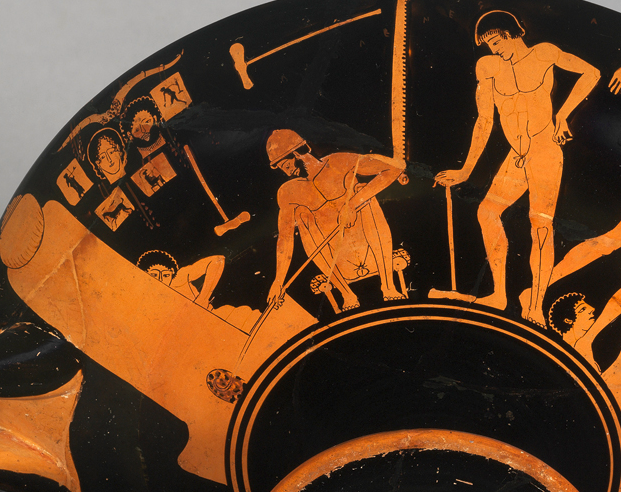
The Berlin Foundry Cup
What The Foundry Cup illustrates is not the melting of bronze but the breaking up of scrap bronze (e.g. Persian armour) into pieces small enough so that a loaded crucible of small pieces would suffice for such a large casting. The man waiting with a large hammer beside the stove to smash the heated bronze confirms my interpretation. If large pieces were used the crucible would have to be loaded many times and the melt would be too slow.
Bronze needs to be melted fast, or the white metals necessary to make the alloy flow - lead, zinc and tin, will be driven off and the remaining copper will not pour as liquid. This happened to Cellini casting his Perseus. He wisely threw in his household pewter to replace the lost metals and saved the day. Bronze varies in constituents but it is normally approximately 85% copper and 15% the aforementioned white metals.
The eminent archaeologist Herbert Hoffman wrote two papers for the Oxford Journal of Archaeology (vol. 21 no.2 May 2002 & vol. 23 2003) describing my discoveries. He wrote “Classical archaeologists have seriously underestimated the output of heat required to melt a large quantity of bronze and have therefore wrongly reconstructed the ancient casting process”.
I knew that a dozen men with bellows would not be up to the task of melting sufficient bronze for the legs and torso of one Riace figure. (The restorers of the figures found that these were cast in one piece). A good sized chimney is necessary to melt that much bronze. I went to Athens in search of one. In fact I found two that could seriously compete with a 19th C industrial chimney: one on the Acropolis rock in Athens and the other on the Hill of Kronos in Olympia (both associated with Phidias and his workshop). The one in Olympia is visible on a contour map as a sharp indentation cut into the hillside. The bottom end of this indentation is the site of three excavated ancient furnaces; which is proof enough of the chimney. The one in Athens is a C shaped groove cut in the Acropolis rock just beneath the Parthenon. This section is tall enough to walk in. Both chimneys' remains need a wall or roof to complete the structure, but it is not difficult to imagine the necessary bricks or stone were recycled when they were no longer needed for a chimney.
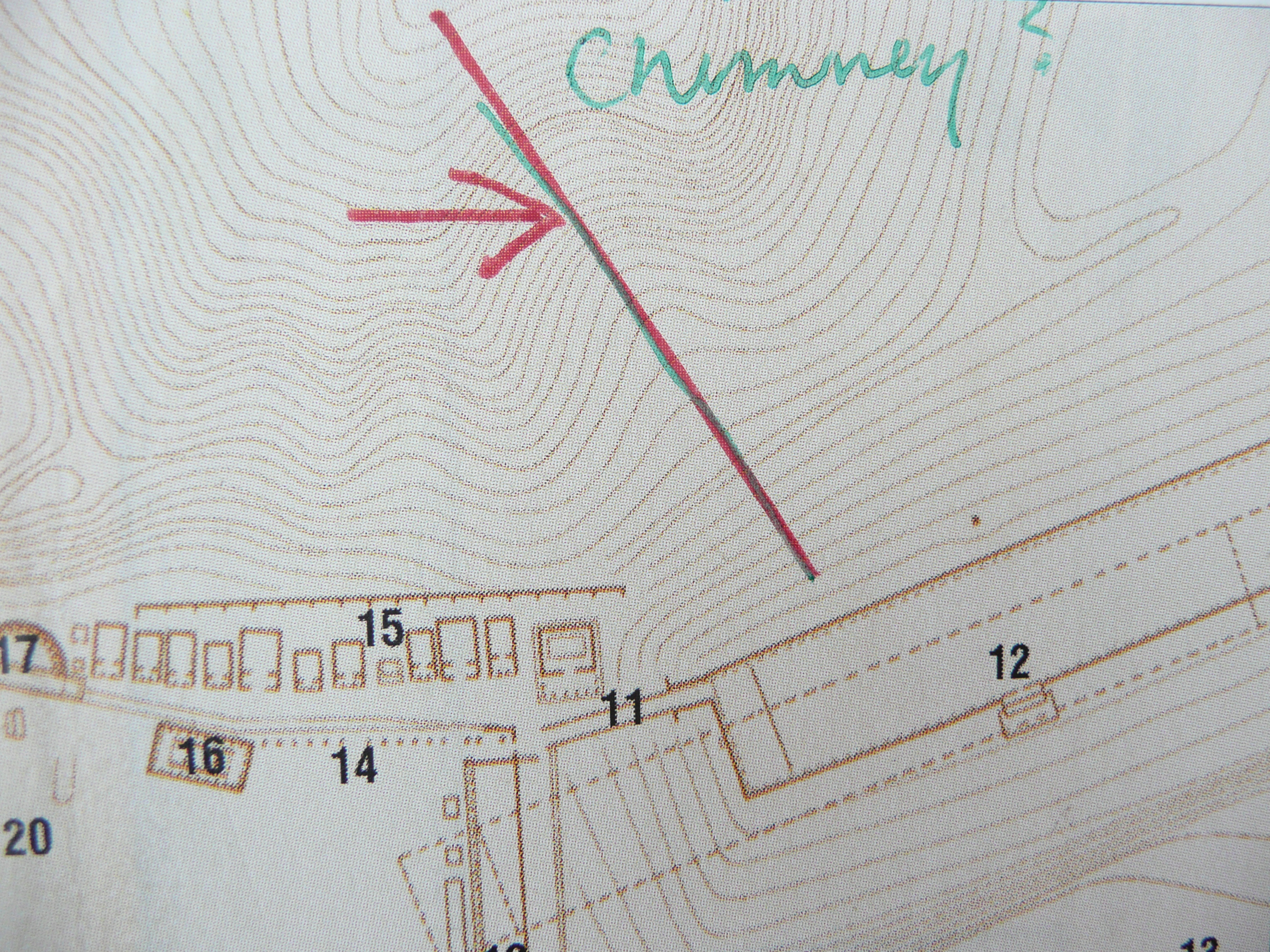
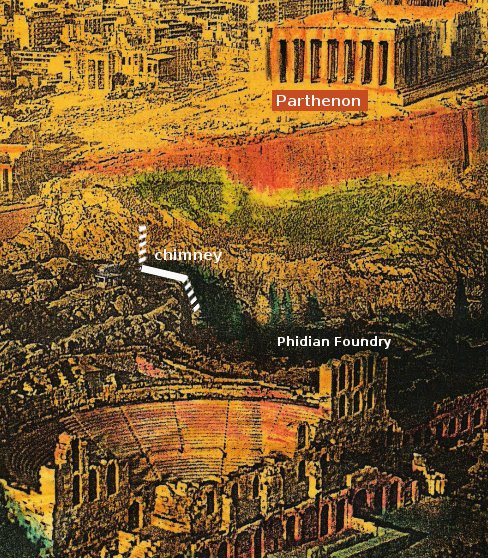
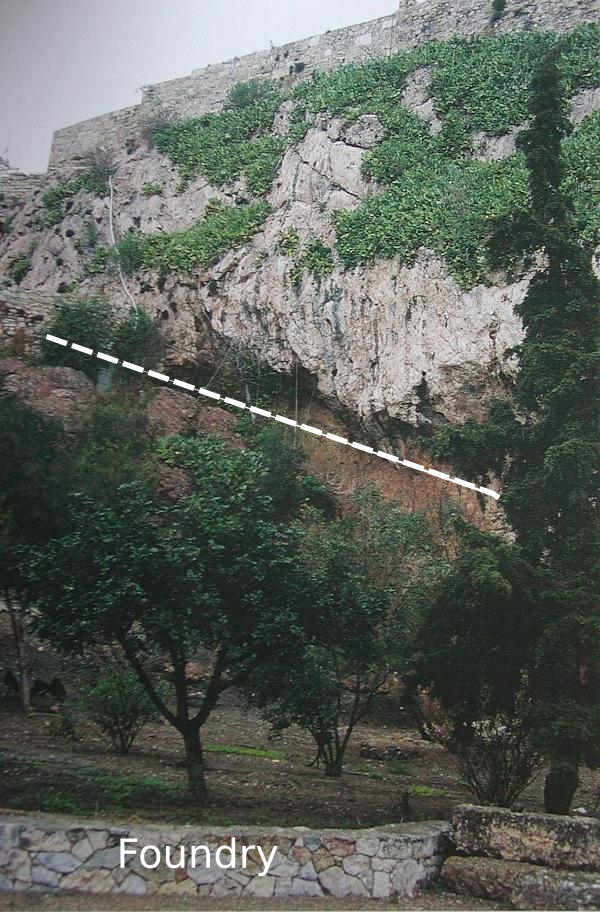
Position of the chimney: Left-Top - on a contour map; Left-Bottom - Relative to the Parthenon; Right - The line of chimney seen from the Phidian foundry at bottom
The chimney in Athens has a satisfactory foundation for the missing wall. It also exhibits massive evidence of its use as a chimney in the form of soot and discolouration of the rock due to heat.
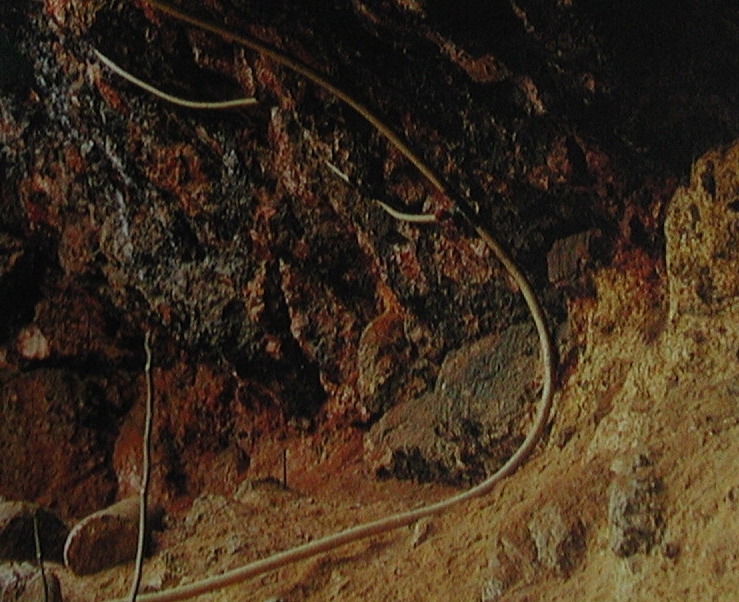
Within the chimney black tars and discolouration due to heat.
I imagine that excavation will reveal traces of a furnace near the bottom end. The angle of the groove is rather less than one might expect for a chimney but the matrix of rock would have the advantage of retaining the heat so that the pull of the chimney would probably operate satisfactorily after a month of non-use. The angle of the chimney, approx 40 degrees I take to be the angle of the natural strata. At the top the soot deposit ends suddenly and I therefore hypothesise a tower chimney that would have taken the smoke up to a point 150 m upwind from the Parthenon.
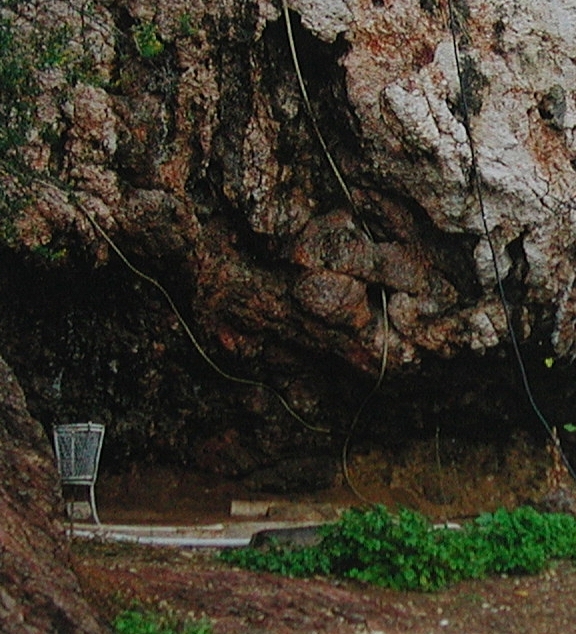
The top of the diagonal section of the chimney showing how the smoke pollution ends suddenly therefore there must have been a tower chimney taking the smoke up to Parthenon level.
Early photographs of the Parthenon still exhibit evidence of soot two thousand years after the event. Even today the interior and ceiling will supply enough soot to confirm my thesis. At one stage the Parthenon must have been as black as Manchester. Alas, The British School at Athens still refuses to make the necessary carbon dating. This is probably because of my second discovery in Greece disturbs accepted teaching as to the origins of Greek classical sculpture.
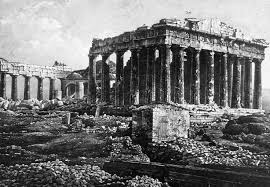
Earliest known photograph of the Parthenon (1839), showing clear distinct dark patches.
There are a number of small technical points in Greek foundry practice which I explain in the second edition of my book Sculpture, the Art and the Practice. These might interest sculptors and foundry-men possibly even archaeologists; they also demonstrate the continuity of Greek practice up to Cellini and even have an affinity with recent practice which has reintroduced mountable ceramic tubes for running the bronze in. Then and now these tubes need to be firmly packed in sand.

Sculpture: The Art and the Practice, available by sending an email to This email address is being protected from spambots. You need JavaScript enabled to view it.
Part 2: Bronze Feet and Life Casting
My second discovery is that The Riace Bronzes and probably many other classical works were cast from life. I would not dare make such a disturbing statement unless the evidence was beyond dispute. The evidence is in the soles of the feet, which are completely naturalistic and show clearly the weight of the model standing on them. They could not have been seen, nor would they ever be seen on the finished sculpture, the soles must have been cast. The rest of the body has the same extreme naturalism we can therefore reasonably assume they were also cast from a living man (albeit an exceptionally tall one, around 2 m tall). The wax taken from the mould would have been worked over to eliminate unsightly wrinkles etc.
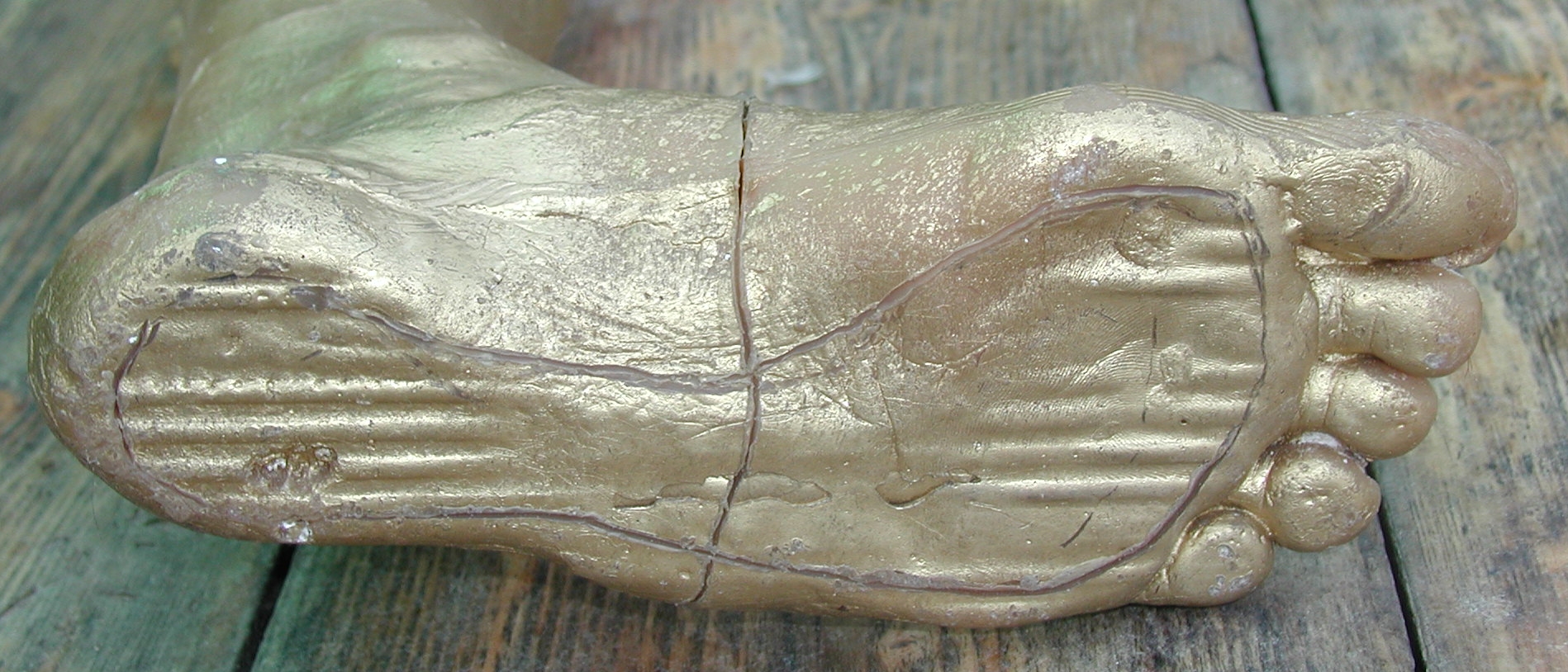
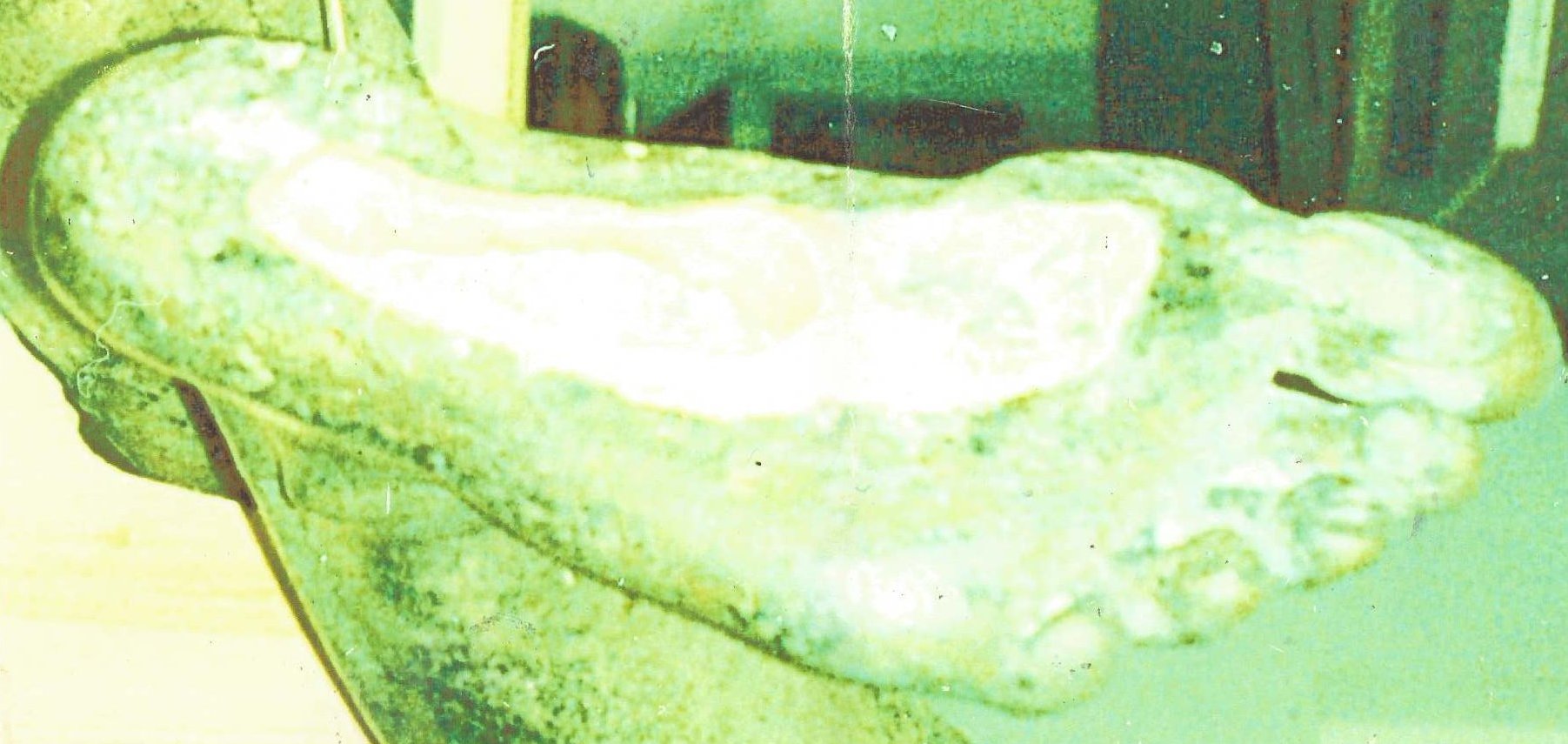
Left: Foot cast by NK with model standing into plaster puddle
Right: The bottom of foot of Riace A - the sole has been cut out to support the core during firing but what remains is naturalistic.
The same evidence is also blatantly obvious in The Apollo of Piombino and it is my guess that it was the motive for the vicious dispute that broke out when that sculpture was restored at the Louvre over 150 years ago. Life-casting must have been known to a small coterie of archaeologists then but it has not been published or referred to since. Nor has my publication caused a whisper of descent or acclaim. The subject remains taboo though the elder Pliny told us the same over 2000 years ago. My discovery puts the practice 150 years earlier than Pliny, at the very start of the classical period in Greece, the crucial starting point for most histories of art.
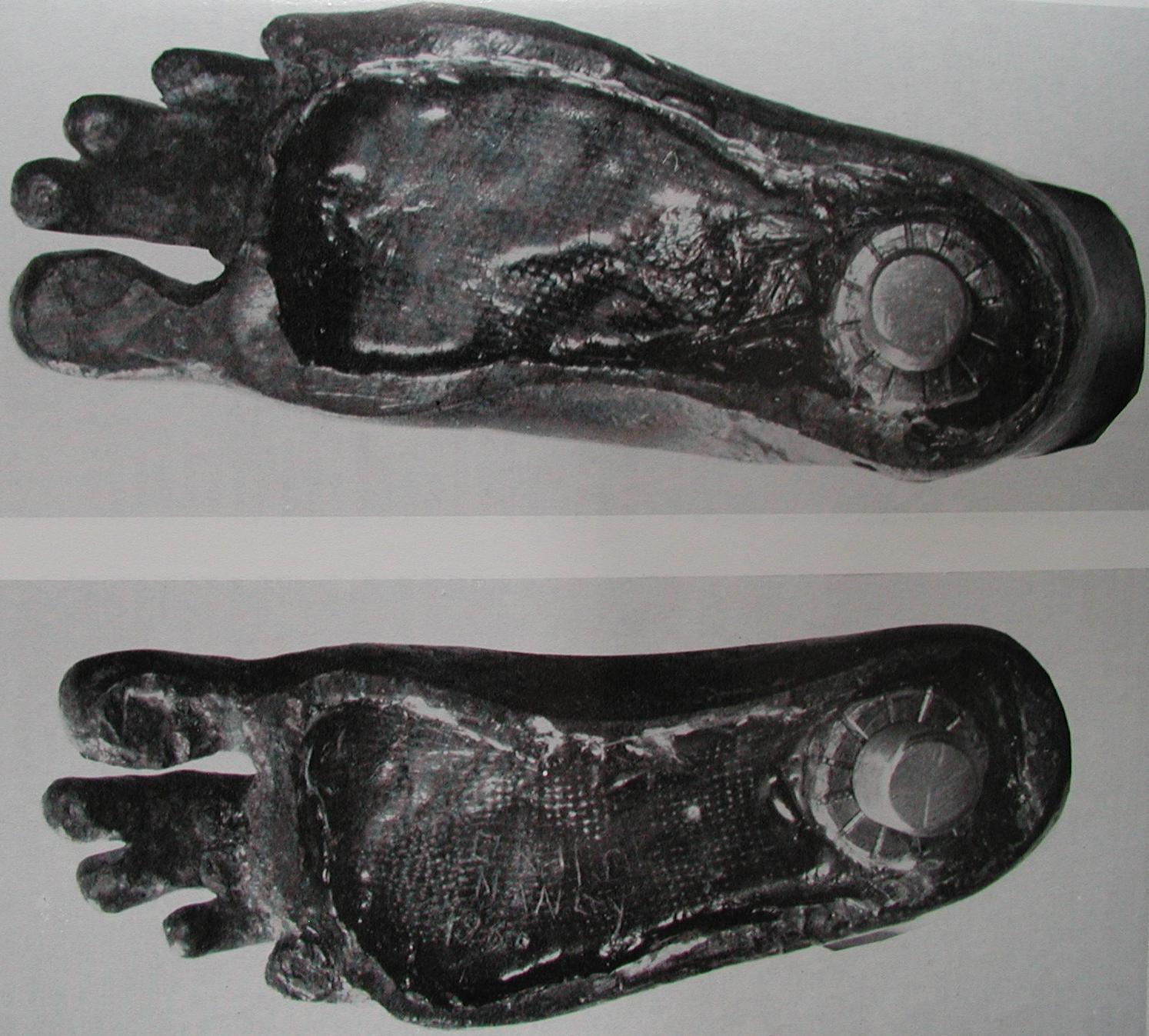
The Apollo of Piombino's feet are clearly cast from a child as is his body.
The Greek sculptural development happened amazingly quickly, between 500 and 470 BC. When we compare a similar development in the prerenaissance, we find the Italians took four times as long as the Greeks, even though they had many Greek and Roman examples to guide them. Furthermore, the Italians studied anatomy which was not done in ancient Greece. Life-casting must be the explanation. Further details of the processes can be found in the above mentioned book.
*********************
When I first entered the room in the museum in Reggio Calabria where these bronzes are shown I was immediately aware of being in the presence of the greatest examples of the Greek classical period, for many the summit of the history of sculpture. Their stance is eloquent of their state of mind, their finish is extraordinary. They have inlaid eyes and eye-lashes, figure A even has silver teeth, both have copper lips and nipples.
I had seen the two bronzes that are the nearest equivalent to the Riace pair – The Charioteer from Delphi and The Poseidon in Athens. They are also wonderful, The Poseidon (or maybe Zeus) is throwing a trident or a thunder-bolt, his movement is caught in that moment, drawing back before he throws, he is majestic, his forms are not quite as clear as the Riace pair. I do not doubt that he also started from a life cast, possibly of the same heroic model. The change of pose being effected by simply cutting and repositioning the limbs of the wax original.
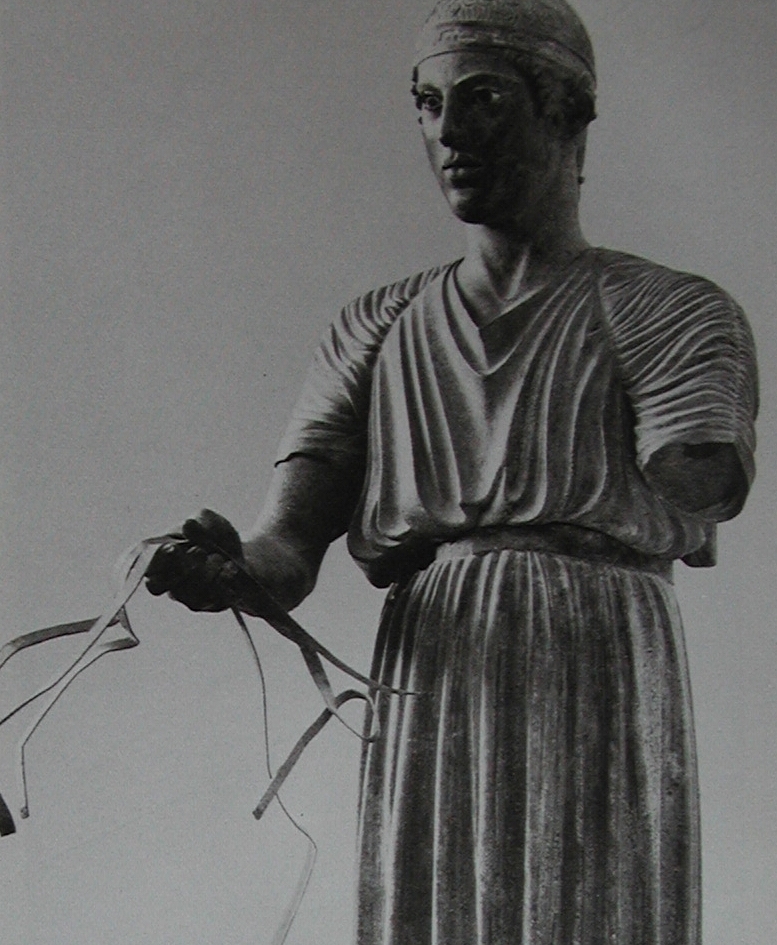
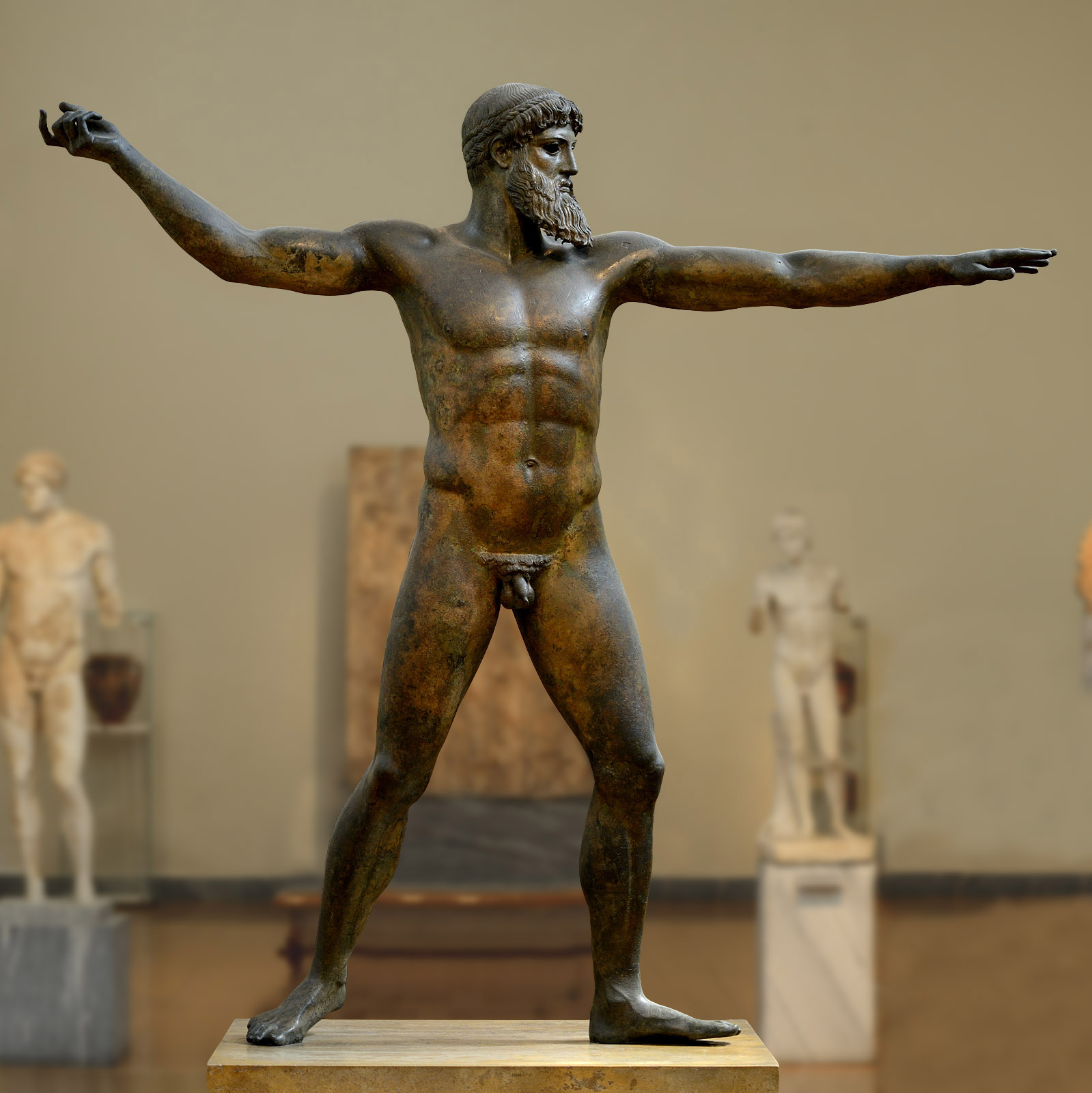
Left: The Charioteer; Right: The statue of Poseidon (or possibly Zeus)
The Charioteer is wonderfully finished with the same workmanship in the eyes as the Riace pair and the same clarity of form. Though he is a charioteer there is not the slightest indication of the act of driving, no wind, no sense of balancing on a fast moving vehicle, he stands as if on a pedestal. He holds the reins and that is how we know he is a charioteer. He wears a pleated gown which I guess was stiffened with glue or starch before the plaster was added for the casting. Another, easier way of achieving the same effect would be to dip the garment in wax and drape it on the model probably cut in sections for easy working. This waxed sheath could then be used complete with the cloth as the former for the lost wax process because the material will burn out along with the wax leaving little trace. The Charioteer's forearms and naked feet resemble the Riace pair very much. My guess is both sculptures will exhibit the same soles of their feet as the Riace pair.
From the evolution of Greek sculpture we can deduce their ambition was to make as life-like a figure as possible. Phidias or his associates found a direct way of achieving this likeness. Is he to be blamed for using it? Rather we should blame archaeologists for hiding it.
Part 3: Smoke Damage in the Parthenon
My Third Discovery has not been previously published. There are a number of anomalies about the marbles that my observations could explain. There is massive evidence for the existence of the chimney described above within the Parthenon itself. Accumulations of soot adhering to the structure exactly as one would expect from the chimney I discovered 150 m upwind from the west facade. It would have been belching wood smoke for perhaps centuries from around 470 BC (the date given to the early Greek large bronzes. Pliny tells us that there were 1000 bronzes on the Acropolis in Athens). The outside of the Parthenon has since been cleaned but the inside particularly the ceiling and upper parts still bear witness to considerable smoke pollution. I would therefore expect the west pediment to be blacker and more eroded than the east pediment. In fact it is considerably lighter and though much more damaged; according to a drawing made in 1674 most of the damage occurred when the Parthenon was blown-up under bombardment from the Venetians in 1687. The explosion caused most damage towards the east end of the structure so the question arises how come the east pediment is so much better preserved than the west? In the main it is also darker than the west.
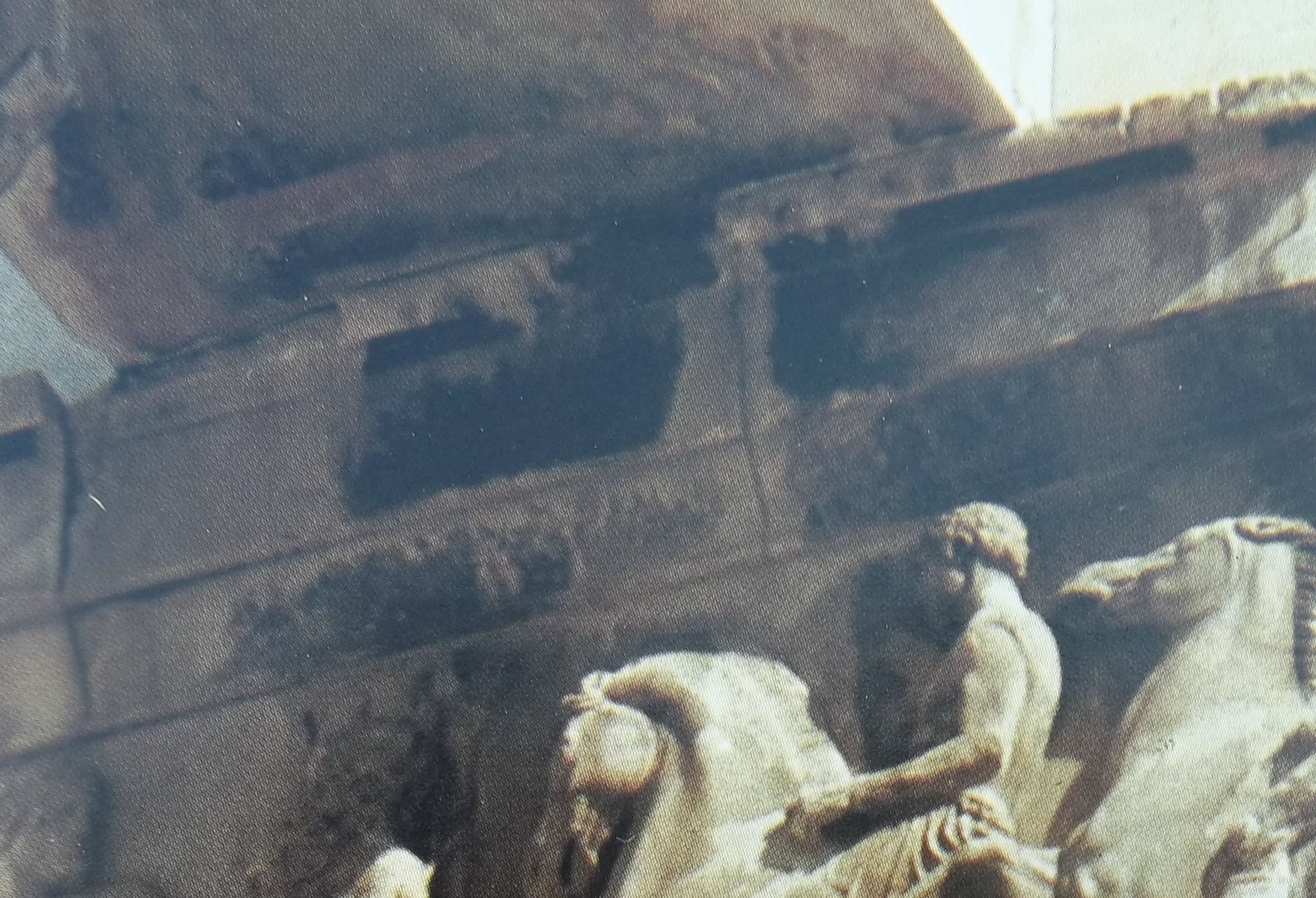
Inside the Parthenon showing staining on the smoke's path to the east pediment.
I think we can rule out the possibility that the smoke was caused by the explosion as the fire would have been over in a matter of hours at most. The deep penetration of the smoke left on the east pediment is the result of years, more probably of centuries of pollution. Under the left knee of the Dionysus figure one can see how the smoke, having traversed the whole length inside the Parthenon has seeped up and licked away a portion (about the size of a man's hand) of the stone to the depth of more than a centimetre. Such damage can only occur over time. The same sense of the smoke rising as it leaves the building is apparent on the under side of his right calf and in fact to a lesser extent to the underside of many of the arms of other figures. This is most easily seen from the back.
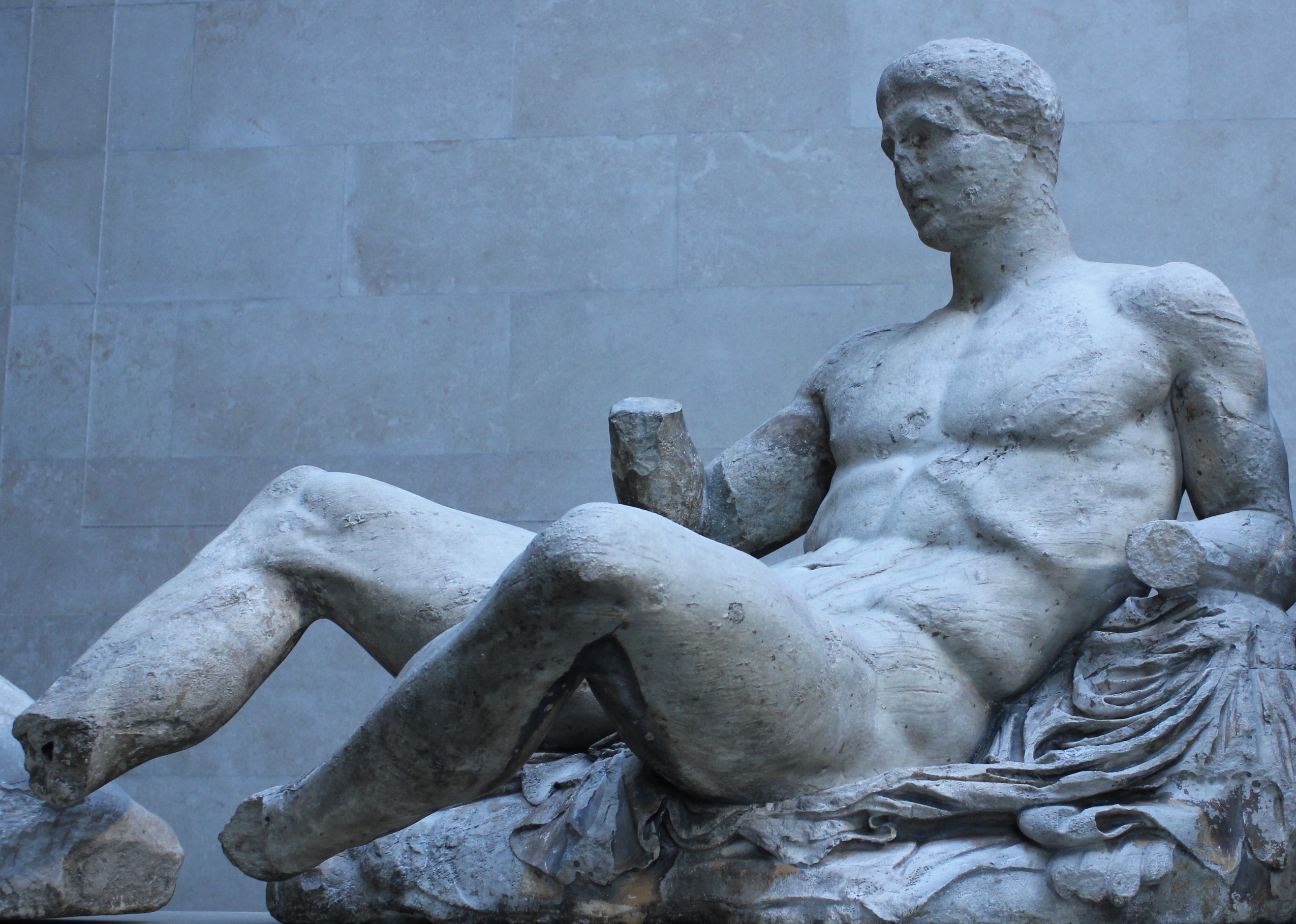
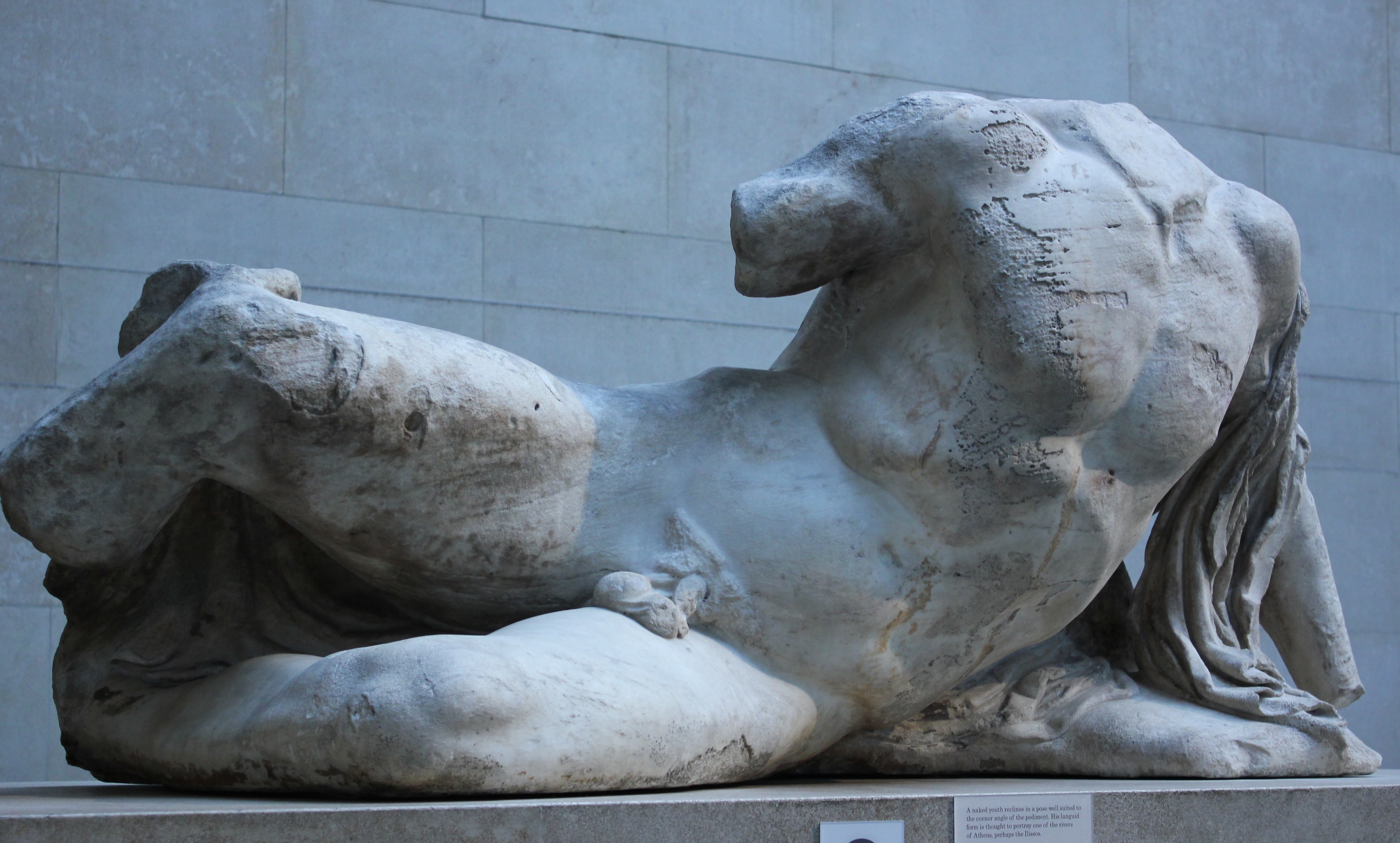
Left: Dionysus - From the eastern pediment is stiffer more severe style is heavily polluted, the marble looks like lime-stone
Right: Ilissos - from the west Pediment is more vividly alive and the marble on his chest looks like marble - This sculptor is not some copyist hack - he is a Bernini of ancient Rome
There is no evidence of smoke damage on the west pediment. The damage is more the result of fracture than of erosion. The answer to these anomalies may be explained in C. Bluemel's Greek Sculptors at Work*. The technique of carving changed with the coming of steel. Before steel, iron or bronze tools were used for craving and the fragile nature of these materials meant that the tools were used much more gently. The tool was tapped at right angles to the surface with a pecking action that bruised the surface and gradually chipped away stone but at the same time bruised the marble beneath to a considerable depth (see illustration below) so that the marble no longer looks like marble but more like lime-stone. In the case of the east pediment only the single horse's head (The Horse of Selene) actually looks like marble; the muzzle and lower jaw would have been particularly vulnerable as they overhand the pediment. The rest has the bruised look and I guess the smoke seeped in to the tiny fissures and so resisted the many cleanings the works have undergone. Epstein was scandalised by the force used cleaning on the orders of Duveen.

The Horse of Selene

The statues from the eastern pediment (right, centre) are clearly more smoke damaged and discoloured than those from the west pediment (left), which show no evidence of such damage, even though the east pediment was further away from the chimney. The dark yellow on the stool is probably the remains of the original paint.
The west pediment in contrast does look like marble when cleaned it also behaves like marble. The smoke has not penetrated the more compact surface, nor for that matter has the original paint which has survived in parts of the east pediment but there is no trace of it on the west, either because it was never painted or more probably because the marble was carved with steel so neither paint nor smoke has penetrated.
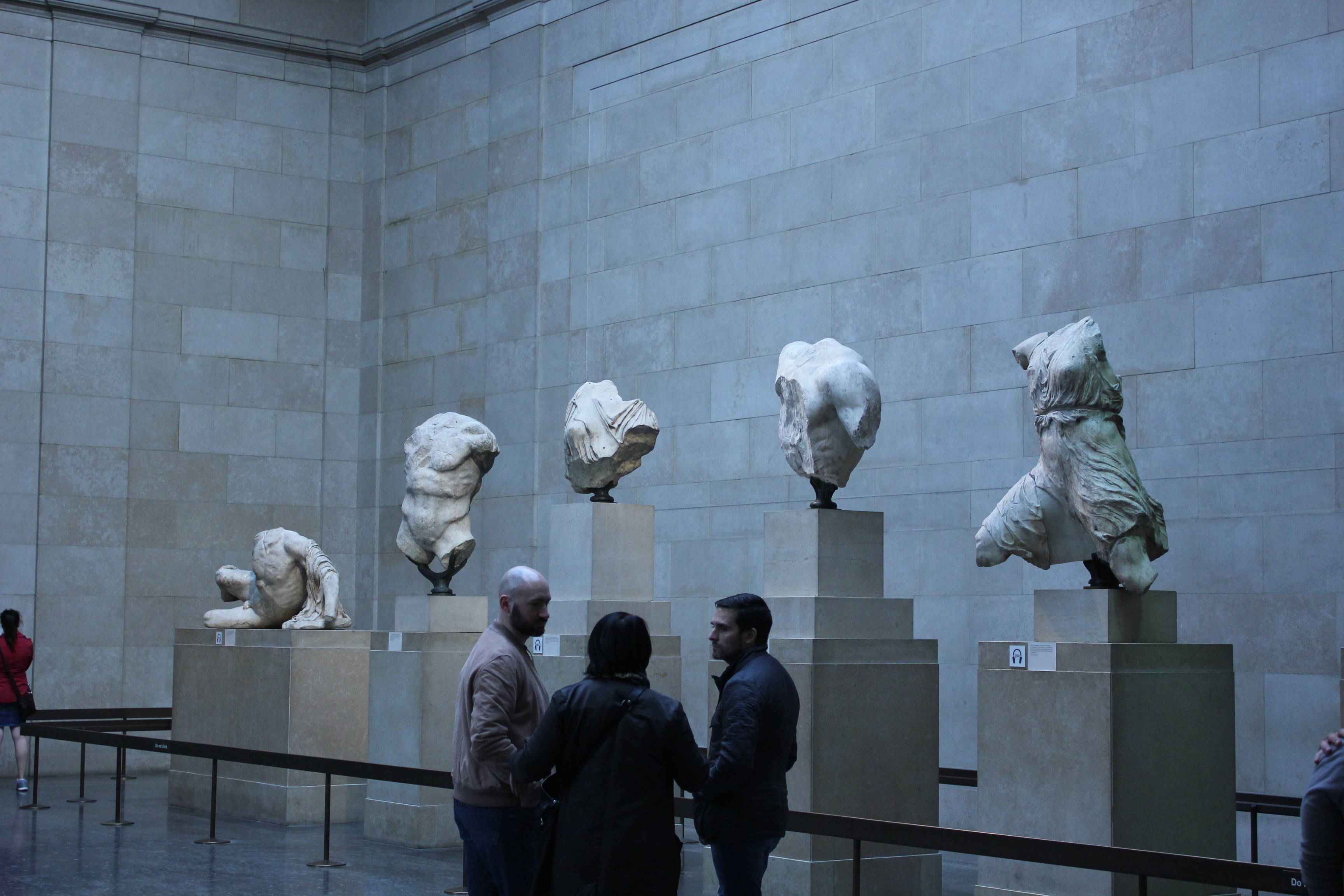
West Pediment
What I am suggesting is that the west pediment was so damaged by the smoke from the chimney the sculpture had to be replaced centuries later and was therefore carved with steel tools. Most likely on the orders of the grecophile Hadrian (117 - 138 AD). A comparison of the style of the two male nudes Dionysus on the east and Ilissos on the west confirms this view. Looking at the naturalism of the belly of Ilissos for instance one can believe it was observed from life in that distended pose. Where the belly of Dionysus one might be forgiven for mistaking for the severe style of around 470 BC rather than 448 BC when we know the Parthenon was started. Judged by the Greek standards of nearness to life, dare I say, I much prefer the artistry of of the later work.
Dionysus' belly lacks the bulges and elasticity of nature so apparent in Ilissos. Ilissos is by far the best preserved figure on the west pediment but the quality of the surface of the other less complete figures on the west pediment should suffice to persuade us that they were also replacements for earlier figures. This suggestion is based on what can be seen by the naked eye. I feel sure that science has some way of probing the stone to see if it was carved by bruising or cutting (iron or steel) which could decide the dating finally for us. I have no explanation for the way great damage was caused to the west pediment and none to the east in the bombardment of 1687, other than cannon balls from the west. I think these observations adequately explain the anomalies in the distribution of soot and damage.
*Carl Bluemel, Greek Sculptors at Work Phaidon 2nd English edition 1969 p.46 to 52 illustrate measuring bosses and other measuring evidence which he dates around 460 BC. On pages 38 to 44 he offers very unconvincing (to me) methods of copying maquettes in practise. My suggestion of using cut up pieces from a hollow wax life-cast for the same purpose is very much more possible. The wax would, of course, need to be protected from the sun. His points about the immobility of a clay original is completely valid.
CORRECTION - I am grateful to Dr Ian Jenkins of the British Museum for pointing out that Richard Payne Knight had made a similar suggestion at the time of purchase of the marbles by the government from Elgin (c.1811). With this article I have simply added evidence that should add weight to his original observations.
